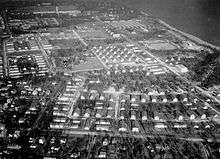Sheridan Reserve Center
|
Fort Sheridan Historic District | |
|
Fort Sheridan water tower and barracks complex | |
| Location | Fort Sheridan, Illinois |
|---|---|
| Built | 1889 |
| Architect | Holabird & Roche; Office of the Quartermaster General |
| NRHP Reference # | 80001379 |
| Significant dates | |
| Added to NRHP | September 29, 1980[1] |
| Designated NHL | April 20, 1984[2] |
The Philip H. Sheridan Reserve Center is the former Fort Sheridan now in Lake Forest, Highwood, and Highland Park[3] in Lake County, Illinois, United States. It was originally established as a United States Army Post named after Civil War Cavalry General Philip Sheridan,[4] to honor his services to Chicago. When the main fort was officially closed by the Army on 3 May 1993,[5] the majority of the property was sold by the Department of Defense to commercial land developers. Most of the original housing structures were then refurbished and resold as a residential community. Other buildings were given to cultural organizations like Midwest Young Artists, the largest youth music program in the Midwest. Approximately 90 acres of the southern end of the original post were retained by the Army; there the Army now operates the Sheridan Reserve Center complex.
History

The Commercial Club of Chicago, concerned since 1877 with the need for a military garrison, was motivated by the Haymarket Riot in 1886 to arrange for the donation of 632 acres (2.6 km²) of land to the Federal Government for this purpose. Troops arrived in November 1887 to what was initially called Camp Highwood. A year later, Camp Highwood was renamed Fort Sheridan. Troops stationed at Fort Sheridan were used in 1894 to quell labor unrest during the Pullman Strike.
Fort Sheridan became a mobilization and training center beginning with the Spanish–American War in 1898. Following World War I, Fort Sheridan processed nearly 20,000 returning wounded soldiers and helped them return to civilian life through physical and occupational training reenter the workforce.[6] During World War II, over 500,000 men and women were processed through military service. Many army officers who later became famous lived there, including George Patton and Jonathan Wainwright. The 174th Military Police Battalion of the Leavenworth, Kansas National Guard was stationed there in 1950. Fort Sheridan served as the base for supplying and servicing Nike antimissile systems in the upper Midwest from 1953 to 1973, at which point it returned to providing administrative and logistical support services.
The 94 buildings in the Historic District, built between 1889 and 1910, include 64 structures that were the first major works of the architectural firm Holabird & Roche of Chicago. These earliest buildings are made of bricks molded and fired on site, using clay mined from lakefront bluffs. The water tower, originally the tallest structure in the Chicago area, was altered and shortened by 60 feet (18 m) in 1940. The row of buildings flanking the tower were troop barracks. The 110 acre (450,000 m²) Historic District, placed on the National Register of Historic Places in 1980, was designated a National Historic Landmark in 1984. In 1979, the site was documented by the Library of Congress Historic American Buildings Survey.
In 1979, director Robert Redford used a warehouse on the base to build interior sets for his Oscar-winning film Ordinary People.
Fort Sheridan closed in 1993. The decision to close Fort Sheridan came in the 1989 first round of base closings under the Base Realignment and Closure Act (BRAC).
An Army Reserve base continues to use about 90 acres (360,000 m2) of the original Post. The remaining property is divided between the Lake County Forest Preserves, a residential development, a Navy family housing development for personnel of nearby Great Lakes and a variety of ongoing commercial developments.[7]
Environmental concerns
The geological setting of Fort Sheridan is tableland above a 70-foot (21 m) high bluff[8] in an area cut by seven deep ravines. The bluff overlooks Lake Michigan and the ravines create an open face in the bluff at the beach’s edge. Over the years, the Army filled in the ravines with waste generated by military operations. The most toxic waste was placed in the Wells Ravine, also known as Landfill 7. The United States Environmental Protection Agency considers Landfill 7 to be a Superfund National Priorities List (NPL) location.[9] The landfills were not operated in an environmentally sound manner.[10] An IEPA permit was not issued while the landfill was operating, and a high-density plastic containment liner was not used between the ravine and the waste. Regulatory oversight did not begin until 1979 when the State of Illinois commenced litigation. An operating permit was issued two months after the landfill ceased operations.[11] The Army then applied for a closure permit, installed a leachate collection system, and placed a clay cap over Landfill 7. By 1982, the cap had failed due to ponding of water and the failure of the leachate collection system to collect leachate. The Army stated that the cap failure was caused by failure to maintain the cap.
By 1989, Fort Sheridan was facing potential closure by the Base Realignment and Closure commission. The Army began evaluating the permanent closure of Landfill 7 and the inherent problems with its maintenance. Because Landfill 7 had been dispensing 14,000 gallons of leachate per day into Lake Michigan, and the leachate was above state environmental effluent standards, CERCLA allowed the Army to implement an interim remedy prior to deciding on a permanent remedy. The Army chose to construct a $16 million cap.[12] Public comments for this interim action opposed the cap,[13] focusing on the Army's characterization of the type of waste in the landfill, the geologic instability of the ravine and bluff environment, and the proximity to Lake Michigan from which local drinking water is drawn. The Army responded that the cap was an interim solution that was thought to be effective for temporary containment of the waste.
After the interim containment remedy was selected on April 22, 1997,[14] the Army brought in Dr. Shabica to evaluate the shore protections as part of the design phase. On December 2, 1997, he informed the Army that the cap, as designed, would fail due to erosion. The Army responded by purchasing a new system designed by Dr. Shabica's company.[15] The interim cap was completed in June 2004, and the Army may propose making capping the final remedy based on the same analysis that supported the interim action.[16]
The decision to cap Landfill 7 as the final remedy conflicts with some of the recommendations of the geological community. The Army is the lead agency in determining cleanup alternatives. Opponents claim the Analysis of Alternatives found in the remedial investigation, remedial action, and feasibility study was skewed in favor of the Army’s preferred remedy which was less expensive.[17] According to the FY2006 Defense Environmental Restoration Program Annual Report To Congress, $58.7 million in cleanup funding had been appropriated for Fort Sheridan. Estimated cost to completion was $22.2 million estimated for FY2003.[18]
References
- ↑ National Park Service (2007-01-23). "National Register Information System". National Register of Historic Places. National Park Service.
- ↑ "Fort Sheridan Historic District". National Historic Landmark summary listing. National Park Service. Retrieved 2007-10-03.
- ↑ http://www.fortsheridan.com
- ↑ Gannett, Henry (1905). The Origin of Certain Place Names in the United States. Govt. Print. Off. p. 129.
- ↑ The Town of Fort Sheridan, IL - About Fort Sheridan
- ↑ "The Reawakening", 1919
- ↑ Fort Sheridan
- ↑ Illinois Department of Transportation; Division of Water Resources. Harmony with the Lake: Guide to Bluff Stabilization, Lake Michigan, IL. The Illinois Coastal Zone Management Program.
- ↑ US EPA Region 5 Superfund Division, Fort Sheridan.
- ↑ Argonne National Laboratory. Enhanced Preliminary Assessment Report: Fort Sheridan 1989 pg. 24.
- ↑ Id at 13, 24.
- ↑ Walsh, Don and Liberman, Polina, Fort Sheridan Landfills 6 & 7 Closure. Department of Civil & Environmental Engineering, Northwestern University on behalf of Chicago Environmental Law Clinic August 2003 pg 26. Northwestern University study.
- ↑ Responsiveness Summary. Mayor Geraci of Highland Park, Mayor Sirotti of Highwood, the League of Women Voters of Lake Forest/Lake Bluff/Highland Park, the Lake Michigan Federation, and the Sierra Club all opposed the interim capping action.
- ↑ USACE, Decision Document (DD) for Interim Source Control Action for Landfills 6 and 7 at Fort Sheridan, Illinois. April 22, 1997.
- ↑ Shabica, Charles W. and Charles Shabica & Associates. Review of Erosion Control Features for Interim Remedial Action Landfills 6 & 7, Fort Sheridan, Illinois, November 25, 1997.
- ↑ Microsoft Word - Proposed Plan Landfills 6 & 7 Final Remedy Final.doc
- ↑ Walsh, Don and Liberman, Polina, Fort Sheridan Landfills 6 & 7 Closure. Department of Civil & Environmental Engineering, Northwestern University on behalf of Chicago Environmental Law Clinic August 2003 pg 26.
- ↑ Defense Environmental Restoration Program Annual Report To Congress FY2006, page 84.
Further reading
- Dahl, Arthur G. ; Military Training Camps Association (U.S.). The sentinel : Sixth Corps Area. Chicago : Military Training Camps Association of the United States. OCLC 28528203.
- Dretske, Diana. Fort Sheridan. Charleston, SC : Arcadia Pub., 2004. ISBN 0-738-53364-5 OCLC 58726172.
- Fort Sheridan (Ill.). Fort Sheridan, 1887-1993. [Fort Sheridan, Ill? : The Fort, 1993]. OCLC 45632229.
- Girton, Fred. The history and achievements of the Fort Sheridan officers' training camps.[Chicago?] The Fort Sheridan Association [1920]. OCLC 567331.
- Haberkamp, Douglas B. The history of Fort Sheridan from its beginnings to World War I. 1980. OCLC 8855211.
- Maddra, Sam. Hostiles? : the Lakota ghost dance and Buffalo Bill's Wild West. Norman : University of Oklahoma Press, 2006. ISBN 0-806-13743-6. OCLC 61285768.
- Melichar, Paul ; Melichar, Diana ; Smith, Nina Bennett. Fort Sheridan : historical analysis. Lake Forest, Ill. : Paul Melichar, 2000. OCLC 680744071.
- Schall, Robert. The history of Fort Sheridan, Illinois. [Illinois?] : Clerical School and the Visual Training Aids Section, 1672nd Service Unit, 1944. OCLC 27923469.
- Sorenson, Martha E.; Martz, Douglas A. View from the tower : a history of Fort Sheridan, Illinois. [Fort Sheridan, Ill.] : W.W. Sorenson, 1985. OCLC 15132979.
- Tucker, Laura. Fort Sheridan. Charleston, SC : Arcadia Pub., 2008. ISBN 0-738-55191-0. OCLC 184823770.
- United States Department of the Army. US Army Headquarters, Fort Sheridan, Illinois. [Washington, D.C.?] : [Dept. of the Army], [1987?] OCLC 16538932.
- United States Department of the Army. Fort Sheridan mobilization reserve component handbook. [Fort Sheridan, Ill.] : Headquarters Ft. Sheridan [Dept. of the Army], 1983. OCLC 10214474.
External links
- EPA Region 5, Fort Sheridan
- Globalsecurity.org - Fort Sheridan
- Historic American Buildings Survey (Library of Congress) - Survey number HABS IL-1113
- Nike Historical Society
- Fort Sheridan
